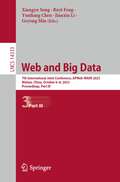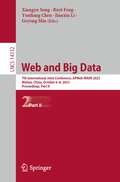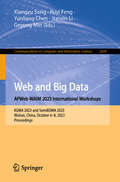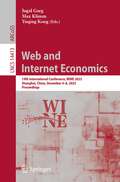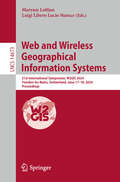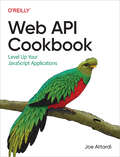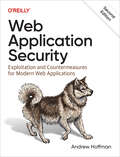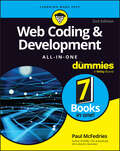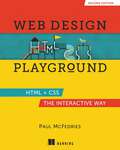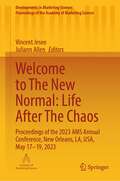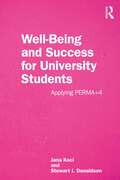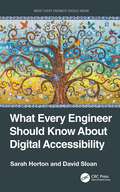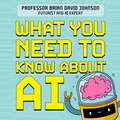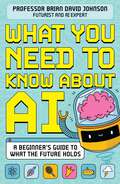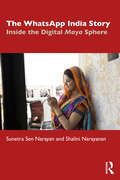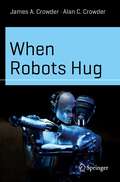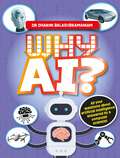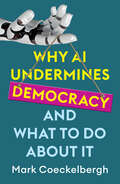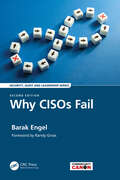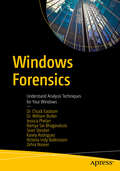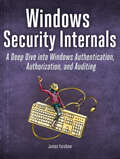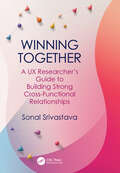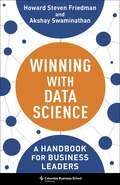- Table View
- List View
Web and Big Data: 7th International Joint Conference, APWeb-WAIM 2023, Wuhan, China, October 6–8, 2023, Proceedings, Part III (Lecture Notes in Computer Science #14333)
by Jianxin Li Geyong Min Xiangyu Song Ruyi Feng Yunliang ChenThe 4-volume set LNCS 14331, 14332, 14333, and 14334 constitutes the refereed proceedings of the 7th International Joint Conference, APWeb-WAIM 2023, which took place in Wuhan, China, in October 2023. The total of 138 papers included in the proceedings were carefully reviewed and selected from 434 submissions. They focus on innovative ideas, original research findings, case study results, and experienced insights in the areas of the World Wide Web and big data, covering Web technologies, database systems, information management, software engineering, knowledge graph, recommend system and big data.
Web and Big Data: 7th International Joint Conference, APWeb-WAIM 2023, Wuhan, China, October 6–8, 2023, Proceedings, Part II (Lecture Notes in Computer Science #14332)
by Jianxin Li Geyong Min Xiangyu Song Ruyi Feng Yunliang ChenThe 4-volume set LNCS 14331, 14332, 14333, and 14334 constitutes the refereed proceedings of the 7th International Joint Conference, APWeb-WAIM 2023, which took place in Wuhan, China, in October 2023. The total of 138 papers included in the proceedings were carefully reviewed and selected from 434 submissions. They focus on innovative ideas, original research findings, case study results, and experienced insights in the areas of the World Wide Web and big data, covering Web technologies, database systems, information management, software engineering, knowledge graph, recommend system and big data.
Web and Big Data. APWeb-WAIM 2023 International Workshops: KGMA 2023 and SemiBDMA 2023, Wuhan, China, October 6–8, 2023, Proceedings (Communications in Computer and Information Science #2094)
by Jianxin Li Geyong Min Xiangyu Song Ruyi Feng Yunliang ChenThis proceedings constitutes selected papers from the Workshops KGMA and SemiBDMA which were held in conjunction with APWeb-WAIM 2023 which took place in Wuhan, China, during October 6-8, 2023. The 7 full papers included in this book were carefully reviewed and selected from 15 papers submitted to these workshops. They focus on new research approaches on the theory, design, and implementation of data management systems.
Web and Internet Economics: 19th International Conference, WINE 2023, Shanghai, China, December 4–8, 2023, Proceedings (Lecture Notes in Computer Science #14413)
by Jugal Garg Max Klimm Yuqing KongThis volume LNCS 14413 constitutes the refereed proceedings of the 19th International Conference, WINE 2023, in December 2023 held in Shanghai, China. The 37 full papers presented together with 29 one-page abstracts were carefully reviewed and selected from 221 submissions. The WINE conference series aims to exchange research ideas in a diverse area of application at the intercept of theoretical computer science , artificial intelligence, operations research, and economics.
Web and Wireless Geographical Information Systems: 21st International Symposium, W2GIS 2024, Yverdon-les-Bains, Switzerland, June 17–18, 2024, Proceedings (Lecture Notes in Computer Science #14673)
by Maryam Lotfian Luigi Libero Lucio StaraceThis book constitutes the refereed proceedings of the 21st International Symposium on Web and Wireless Geographical Information Systems, W2GIS 2024, held in Yverdon-les-Bains, Switzerland, during June 18–19, 2024. The 8 full papers and 7 short papers included in this book were carefully reviewed and selected from 20 submissions. The book also contains one invited talk. They were organized in topical sections as follows: Spatiotemporal Data Analysis, Open Data and Reproducible Research, Geospatial Technologies and Tools, Advanced Computing and GIS Applications, Transportation Applications, and Doctoral Symposium.
Web API Cookbook
by Joe AttardiJavaScript gives web developers great power to create rich interactive browser experiences, and much of that power is provided by the browser itself. Modern web APIs enable web-based applications to come to life like never before, supporting actions that once required browser plug-ins. Some are still in an experimental stage, but many are ready for use today.With this hands-on cookbook, author Joe Attardi helps you explore the powerful APIs available in modern browsers and guides you through the specific tasks that they unlock. Because these features are web standards, there is comprehensive documentation available from trusted resources such as MDN Web Docs. The knowledge you'll gain is transferable across different companies and projects.Learn the breadth of functionality available in modern browser APIsExplore future APIs that are still in an experimental stageDiscover newer elements, such as dialog that replaces the need for a third-party libraryBuild more powerful and interactive web applications using native APIsUnderstand the permissions model used by the browser to unlock functionality such as geolocation and push notifications
Web Application Security
by Andrew HoffmanIn the first edition of this critically acclaimed book, Andrew Hoffman defined the three pillars of application security: reconnaissance, offense, and defense. In this revised and updated second edition, he examines dozens of related topics, from the latest types of attacks and mitigations to threat modeling, the secure software development lifecycle (SSDL/SDLC), and more.Hoffman, senior staff security engineer at Ripple, also provides information regarding exploits and mitigations for several additional web application technologies such as GraphQL, cloud-based deployments, content delivery networks (CDN) and server-side rendering (SSR). Following the curriculum from the first book, this second edition is split into three distinct pillars comprising three separate skill sets:Pillar 1: Recon—Learn techniques for mapping and documenting web applications remotely, including procedures for working with web applicationsPillar 2: Offense—Explore methods for attacking web applications using a number of highly effective exploits that have been proven by the best hackers in the world. These skills are valuable when used alongside the skills from Pillar 3.Pillar 3: Defense—Build on skills acquired in the first two parts to construct effective and long-lived mitigations for each of the attacks described in Pillar 2.
Web Coding & Development All-in-One For Dummies
by Paul McFedriesLearn the in-demand skills that let you turn lines of code into websites and apps Web Coding & Development All-in-One For Dummies is a one-stop resource for would-be developers who need guidance on the languages and steps used to build websites and applications. Learn the coding ropes and expand your existing skillset with this easy-to-understand guide. In these complete mini-books, you’ll walk through the basics of web development, structuring a page, building and processing web forms, and beyond. Learn how to build a website or create your very own app with the advice of web coding and development experts. This edition expands JavaScript and CSS coverage while providing new content on server-side coding and the development stack. Get essential knowledge of how web development works—even if you’ve never written a line of code in your life Learn HTML, CSS, JavaScript, and other languages essential for building websites and apps Discover how to make optimize your sites and apps for mobile devices Expand on what you already know and improve your employabilityThis Dummies All-in-One is great for you if want to develop coding skills but don’t have a programming background. It’s also perfect for professionals looking to brush up on their web development skills and get up to date on the latest trends and standards.
Web Design Playground, Second Edition
by Paul McFedriesEnter the Web Design Playground and start experimenting with all aspects of creating a web page—from design, to development, to publishing—in an easy-to-use free online workspace.This exciting second edition of Web Design Playground is fully updated with new technologies and thoughtful approaches for building modern websites. You&’ll have a blast experimenting with a landing page, photo gallery, portfolio site, and more while you learn important web design skills. In Web Design Playground, Second Edition you&’ll learn essential tools of the web design trade, such as: Structuring a web page with HTML Styling a web page with CSS Modern page layout techniques Using colors in web design Making text look awesome with typography HTML, CSS, and the principles of good web design are all you need to build something beautiful! You&’ll find them all inside this one-of-a-kind guide. Best of all, this book gives you free access to a custom online workspace, the &“playground!&” You can concentrate on core skills like page layout and adding images and video, as well as learning typography, responsive design, and the other modern web design techniques. About the technology If you can use a web browser, you can create a web site! Web Design Playground, Second Edition shows you how, progressing step by step through fun and engaging projects. You learn the basics of HTML, CSS, and other important web skills. With its unique online &“playground,&” the book helps you build a landing page, a photo gallery, a portfolio site, and more, all from scratch. No prior experience or knowledge of special tools is required. About the book Web Design Playground, Second Edition takes a creative, visual approach and clear explanations of the components, concepts, and of each step you&’ll need to build your own web pages. You&’ll become a confident web designer as you practice each new skill in the Playground. The many small projects introduce everything from page layout basics to new tags and features like Flexbox and CSS Grid—all presented in author Paul McFedries&’s inimitably friendly style. Don&’t worry about setting up your own servers and domain names—the book comes with a free online &“playground&” to experiment with and get creative. You can concentrate on core skills like page layout and adding images and video, as well as learning typography, responsive design, and the other modern web design techniques. Before you know it, you&’ll be ready to create gorgeous pages that reflect your creativity and style. About the reader No web design experience required. About the author Paul McFedries has written more than 100 books, which have sold over four million copies worldwide. Table of Contents PART 1 GETTING STARTED WITH HTML AND CSS 1 Getting to Know HTML and CSS 2 Building Your First Web Page 3 Adding Structure to Your Page 4 Formatting Your Web Page 5 Project: Creating a Personal Home Page PART 2 WORKING WITH IMAGES AND STYLES 6 Adding Images and Other Media 7 Learning More About Styles 8 Floating and Positioning Elements 9 Styling Sizes, Borders, and Margins 10 Project: Creating a Landing Page PART 3 LAYING OUT A WEB PAGE 11 Learning Page Layout Basics 12 Creating Page Layouts with Flexbox 13 Creating Page Layouts with Grid 14 Designing Responsive Web Pages 15 Project: Creating a Photo Gallery PART 4 MAKING YOUR WEB PAGES SHINE 16 More HTML Elements for Web Designers 17 Adding a Splash of Color to Your Web Designs 18 Enhancing Page Text with Typography 19 Learning Advanced CSS Selectors 20 Project: Creating a Portfolio Page Appendix A From Playground to Web: Getting Your Pages Online
Welcome to The New Normal: Proceedings of the 2023 AMS Annual Conference, New Orleans, LA, USA, May 17–19, 2023 (Developments in Marketing Science: Proceedings of the Academy of Marketing Science)
by Vincent Jeseo Juliann AllenChange is the only constant that marketers deal with on a regular basis. However, the recent pandemic brought about change for every individual on the planet. It not only brought about changes to technology, but it also reshaped the thinking of consumers and organizations through behavioral and cultural shifts in the market. This volume provides new insights and ideas in marketing research, theory, and practice as we continue to adapt to the new normal world post-pandemic. It provides success stories and regional case studies to offer marketers new ways in which to serve consumers and satisfy their needs. Featuring papers presented at the 2023 Academy of Marketing Science Annual Conference in New Orleans, LA, USA, this book discusses various areas of marketing, each serving as a pillar supporting the overall structure of contemporary marketing built with shared knowledge and aimed toward the future with informed optimism. Founded in 1971, the Academy of Marketing Science is an international organization dedicated to promoting timely explorations of phenomena related to the science of marketing in theory, research, and practice. Among its services to members and the community at large, the Academy offers conferences, congresses, and symposia that attract delegates from around the world. Presentations from these events are published in this Proceedings series, which offers a comprehensive archive of volumes reflecting the evolution of the field. Volumes deliver cutting-edge research and insights, complementing the Academy’s flagship journals, the Journal of the Academy of Marketing Science (JAMS) and AMS Review.
Well-Being and Success For University Students: Applying PERMA+4
by Jana Koci Stewart I. DonaldsonWell-Being and Success for University Students: Applying PERMA+4 is grounded in the science of well-being and positive psychology and teaches students how to strengthen their health and well-being, as well as to make their study journey more enjoyable and successful. Higher education has changed dramatically during the last few years, and given the massive growth of mental health challenges among students, universities and faculty have recognized the need to help students to strive, not only survive. Universities have a great potential and responsibility to promote the well-being of their students. This book provides students with information, motivation, and skills to build their own unique well-being and helps colleges to produce more well-being in the university culture. Students and faculty will be introduced to PERMA+4, an evidence-based framework for enhancing well-being and positive functioning, including academic performance. This book emphasizes practical applications of findings from the best available research to have students learn several steps they can take to strengthen their well-being and academic performance. Individual chapters talk about popular topics of positive psychology such as positive emotions, engagement, relationships, meaning, achievement, physical health, mindset, environment, and economic security. Each chapter summarizes the knowledge on specific topics, invites students to assess their well-being in the particular life domain, and encourages them to explore and try activities and evidence-based interventions to learn how to care for their own mental and overall health. This book not only serves as a guide for students but also as a useful tool for professors seeking to enhance their courses and programs with well-being promotion and student wellness centers across the world.
What Every Engineer Should Know About Digital Accessibility (ISSN)
by Sarah Horton David SloanAccessibility is a core quality of digital products to be deliberately addressed throughout the development lifecycle. What Every Engineer Should Know About Digital Accessibility will prepare readers to integrate digital accessibility into their engineering practices. Readers will learn how to accurately frame accessibility as an engineering challenge so they are able to address the correct problems in the correct way.Illustrated with diverse perspectives from accessibility practitioners and advocates, this book describes how people with disabilities use technology, the nature of accessibility barriers in the digital world, and the role of engineers in breaking down those barriers. Accessibility competence for current, emerging, and future technologies is addressed through a combination of guiding principles, core attributes and requirements, and accessibility‑informed engineering practices.FEATURES Discusses how technology can support inclusion for people with disabilities and how rigorous engineering processes help create quality user experiences without introducing accessibility barriers Explains foundational principles and guidelines that build core competency in digital accessibility as they are applied across diverse and emerging technology platforms Highlights practical insights into how engineering teams can effectively address accessibility throughout the technology development lifecycle Uses international standards to define and measure accessibility quality Written to be accessible to non‑experts in the subject area, What Every Engineer Should Know About Digital Accessibility is aimed at students, professionals, and researchers in the field of software engineering.
What You Need to Know About AI: A beginner’s guide to what the future holds
by Brian David JohnsonThe only book you need on AI - for all curious, fact-gobbling kids age 7+.What actually is AI? Will it take over the world? And one day, will it tidy your bedroom...? In this beginner's guide, learn everything you need to know about AI, from how it helps us discover epic stuff up in space or under the sea, whether it will help you build your very own dinosaur, and why, it won't actually help you write your homework! Written by AI expert and Futurist, Brian David Johnson, you will learn what AI is, where it came from, and how it's already being used in the world of sport, space, medicine, animals and more. You will discover AI's amazing possibilities that might shape the future. And along the way, you'll learn super cool facts, bust some myths, and gain a balanced and informed view on the biggest topic of our time.Designed with fun line illustrations throughout.
What You Need to Know About AI: A beginner’s guide to what the future holds
by Brian David JohnsonThe only book you need on AI - for all curious, fact-gobbling kids.What actually is AI? Will it take over the world? And one day, will it tidy your bedroom . . .? In this beginner's guide, learn everything you need to know about AI, from how it helps us discover epic stuff up in space or under the sea to whether it might help you build your own dinosaur.With AI expert and futurist Brian David Johnson, discover what AI is, where it came from, the incredible ways it's being used today and how it might shape and reimagine your future. Learn that AI is just software and that it won't replace human creativity or imagination, but it could help us do some really cool things. And uncover amazing facts, myth busters and insight from experts around the world!This book offers a balanced, expert and fascinating view on the biggest topic of our time. Designed with fun illustrations throughout.
The WhatsApp India Story: Inside the Digital Maya Sphere
by Sunetra Sen Narayan Shalini NarayananWhatsApp is used by over half a billion people in India today in all fields – in business, corporate and informal sectors, in government, for education and among friends, families and acquaintances. This book critically explores the social messaging app’s rapid expansion in India and its growing influence and looks at whether, as a form of horizontal communication, it poses a challenge to more traditional structures of communication. The book examines WhatsApp’s spread in the personal and professional lives of Indians and the myriad ways in which people in India are using the app in social and business interactions, including among people living with disabilities. Using case studies, interviews, surveys and in-depth research, it analyses key aspects of WhatsApp’s massive popularity and its impact on how people communicate. It also explores its impact on the psycho-social dynamics in India, including the dissemination of fake news and politically motivated content, and the consequent need for media regulation in the country. One of the first books to analyse the pervasiveness of WhatsApp and social media apps in different areas of Indian society, this book will be of interest to scholars and students of media studies, communication studies, digital media, cultural studies, cyberculture studies, sociology and social policy and media law.
When Robots Hug (Science and Fiction)
by James A. Crowder Alan C. CrowderBy 2027, it had been seven years since the scientists’ sea-changing research on artificial psychology and robotics. The work debuted around the same time as Large Language Model Chatbots, and the power of the integration of the two technologies put many industries in a tailspin. The commercial and defense industries especially were still scrambling to regulate their use in research and universities. The sought-after scientists signed with DARPA to build reliable and secure AI entities, but the agency grew fearful of the technology’s power and ultimately decided it was too dangerous to bring to market and demanded the scientists destroy the work. The researchers couldn’t bring themselves to discard 20 years of research, so instead sent the entities to various research labs around the world. But unbeknownst to them, each AI-entity embraced its new home, growing, adapting, evolving, and ultimately connecting beyond what the researchers could envision. In the end, as the scientists catch up to each one, they realize the entities have discovered a very human means of interacting: the power of physical contact; and not physical contact between humans and technology, but physical contact between robotic entities. And with this discovery, the entities join forces to only grow stronger. This development ushers in a new paradigm where the difference between AI-entities and human entities becomes less and less discernible. All the AI and robotic science featured in the book is real; the story line is fictional, but with how fast innovation moves, it’s not hard to envision.
Why AI?: All your questions about artificial intelligence answered by a computer scientist
by Dr Dharini BalasubramaniamAll your questions and worries about Al today - the who, what, where, when and WHY - answered by a computer scientist.It's here and it's not going away - AI is on everyone's mind, but many of us don't know what it is never mind what to think about it! Why AI? is a question-and-answer based exploration of the topic for ages 8 and up, from Dr Dharini Balasubramaniam, a computer scientist at University of St Andrews and a passionate advocate for ethics and education in her field. Dr Balasubramaniam's clear and balanced explanations put our mind at ease, while challenging readers to consider how far AI can and should go in certain areas. She introduces us to the history of the concept of machine learning, the pioneers in the field of AI and the amazing AI doing good in the world today. The book includes case studies on fascinating topics, such as search-engine AI and exciting robotics, and answers questions, such as: What did AI start?; Why do we need AI?; What can AI DO?; What should AI do?; What is the future of AI?
Why AI Undermines Democracy and What To Do About It
by Mark CoeckelberghAcross the world, AI is used as a tool for political manipulation and totalitarian repression. Stories about AI are often stories of polarization, discrimination, surveillance, and oppression. Is democracy in danger? And can we do anything about it? In this compelling and balanced book, Mark Coeckelbergh reveals the key risks posed by AI for democracy. He argues that AI, as currently used and developed, undermines fundamental principles on which liberal democracies are founded, such as freedom and equality. How can we make democracy more resilient in the face of AI? And, more positively, what can AI do for democracy? Coeckelbergh advocates not only for more democratic technologies, but also for new political institutions and a renewal of education to ensure that AI promotes, rather than hinders, the common good for the twenty-first century. Why AI Undermines Democracy and What to Do About It is illuminating reading for anyone who is concerned about the fate of democracy.
Why CISOs Fail: The Missing Link In Security Management--and How To Fix It (Security, Audit and Leadership Series)
by Barak EngelReleased in 2017, the first edition of Why CISOs Fail reimagined the role of the Chief Information Security Officer in a new and powerful way. Written to be easily consumable by both security pros as well as everyone who must deal with them, the book explores the different realms in which security leaders fail to deliver meaningful impact to their organizations, and why this happens. Its central thesis—that security is primarily a human behavioral discipline rather than a technology one—has been gaining increased attention as a core tenet of the field, and the book was ultimately inducted into the cybersecurity canon as a leading book on security management.In this freshly updated edition, Barak Engel adds new sections that correspond with the chapters of the original book: security as a discipline; as a business enabler; in sales; in legal; in compliance; in technology; and as an executive function. He explores new ideas in each operational area, providing essential insights into emerging aspects of the discipline. He then proposes two critical concepts for security management—the concept of "digital shrinkage" and the transition from CISO to CI/SO—that together offer a new paradigm for any organization that wants to become truly successful in its security journey.Why CISOs (Still) Fail is delivered in Barak's conversational, humoristic style, that has attracted a global audience to this and his other book, The Security Hippie. As he notes, the book's goal is to entertain as much as to inform, and he dearly hopes that you have fun reading it.
Wie künstliche Intelligenz Entscheidungen prägt: Eine Multiple-Case-Study über Entscheidungen künstlicher Intelligenz im Kontext von Unternehmen
by Christian ScharffViele Organisationstheorien schließen Technik aus der sozialen Welt aus. Dies wird durch lernfähige Algorithmen infrage gestellt, deren Output sich nicht vollständig auf Menschen zurückrechnen lässt. Es ist deshalb notwendig, die Beziehung von Organisation und künstlicher Intelligenz ergebnisoffen zu untersuchen und zu erklären. Das vorliegende Buch analysiert zu diesem Zweck auf Grundlage einer Multiple-Case-Study, auf welche Weise, aus welchen Gründen und mit welchen Folgen künstliche Intelligenz an den Entscheidungen von Unternehmen beteiligt ist. Es stellt sich heraus, dass die Technik als Entscheidungsträger aktiv an Organisationen teilnehmen und deren strukturelles Fundament prägen kann. Dabei handelt es sich jedoch nur um eine von drei Erscheinungsformen künstlicher Intelligenz. Inwieweit KI-Anwendungen tatsächlich Gelegenheit erhalten, Entscheidungen zu treffen, bestimmen Organisationen nach eigenen Maßgaben.
Windows Forensics: Understand Analysis Techniques for Your Windows
by William Butler Chuck Easttom Jessica Phelan Ramya Sai Bhagavatula Sean Steuber Karely Rodriguez Victoria Indy Balkissoon Zehra NaseerThis book is your comprehensive guide to Windows forensics. It covers the process of conducting or performing a forensic investigation of systems that run on Windows operating systems. It also includes analysis of incident response, recovery, and auditing of equipment used in executing any criminal activity.The book covers Windows registry, architecture, and systems as well as forensic techniques, along with coverage of how to write reports, legal standards, and how to testify. It starts with an introduction to Windows followed by forensic concepts and methods of creating forensic images. You will learn Windows file artefacts along with Windows Registry and Windows Memory forensics. And you will learn to work with PowerShell scripting for forensic applications and Windows email forensics. Microsoft Azure and cloud forensics are discussed and you will learn how to extract from the cloud. By the end of the book you will know data-hiding techniques in Windows and learn about volatility and a Windows Registry cheat sheet.What Will You LearnUnderstand Windows architectureRecover deleted files from Windows and the recycle binUse volatility and PassMark volatility workbenchUtilize Windows PowerShell scripting for forensic applicationsWho This Book Is ForWindows administrators, forensics practitioners, and those wanting to enter the field of digital forensics
The Windows Screen Reader Primer: All the Basics and More
by David KingsburyThe "Windows Screen Reader Primer: Third Edition" offers comprehensive guidance for users of JAWS, NVDA, and Windows Narrator, focusing on essential Windows applications, Office Suite tools, web browsers, cloud-based platforms, PDF readers, and teleconferencing software. With updates for Windows 11 and recent software versions, it includes new chapters on Google Workspace, audio-video editing, and AI integration. The book caters to beginners and intermediate users, providing step-by-step instructions, customizable settings, and practical exercises. Accessible formats and navigation tips enhance usability, making it an invaluable resource for mastering screen reader usage in the Windows environment.
Windows Security Internals: A Deep Dive into Windows Authentication, Authorization, and Auditing
by James ForshawPower up your Windows security skills with expert guidance, in-depth technical insights, and dozens of real-world vulnerability examples from Google Project Zero&’s most renowned researcher! Learn core components of the system in greater depth than ever before, and gain hands-on experience probing advanced Microsoft security systems with the added benefit of PowerShell scripts.Windows Security Internals is a must-have for anyone needing to understand the Windows operating system&’s low-level implementations, whether to discover new vulnerabilities or protect against known ones. Developers, devops, and security researchers will all find unparalleled insight into the operating system&’s key elements and weaknesses, surpassing even Microsoft&’s official documentation.Author James Forshaw teaches through meticulously crafted PowerShell examples that can be experimented with and modified, covering everything from basic resource security analysis to advanced techniques like using network authentication. The examples will help you actively test and manipulate system behaviors, learn how Windows secures files and the registry, re-create from scratch how the system grants access to a resource, learn how Windows implements authentication both locally and over a network, and much more.You&’ll also explore a wide range of topics, such as:Windows security architecture, including both the kernel and user-mode applicationsThe Windows Security Reference Monitor (SRM), including access tokens, querying and setting a resource&’s security descriptor, and access checking and auditingInteractive Windows authentication and credential storage in the Security Account Manager (SAM) and Active DirectoryMechanisms of network authentication protocols, including NTLM and KerberosIn an era of sophisticated cyberattacks on Windows networks, mastering the operating system&’s complex security mechanisms is more crucial than ever. Whether you&’re defending against the latest cyber threats or delving into the intricacies of Windows security architecture, you&’ll find Windows Security Internals indispensable in your efforts to navigate the complexities of today&’s cybersecurity landscape.
Winning Together: A UX Researcher's Guide to Building Strong Cross-Functional Relationships
by Sonal SrivastavaUX research, the key to comprehending users' behaviors, motivations, and preferences for developing delightful experiences, thrives on effective teamwork and collaboration. This comprehensive guide brings together the expertise and insights from seasoned researchers, cross-functional partners, and product leaders in order to transform how you collaborate and unlock the true potential of UX research. Key Features Includes a comprehensive selection of ready-to-use templates Incorporates insights and advice from cross-functional stakeholders Offers a wide range of strategies tailored to various expertise levels, catering to both novice and advanced practitioners Presents universally applicable methodologies and insights, equipping a diverse range of researchers, including consultants, vendors, and in-house professionals From experienced professionals to those just starting out, and freelancers to in-house researchers, this comprehensive guide offers practical strategies to navigate the pitfalls of UX research, enhancing collaboration and, ultimately, driving success.
Winning with Data Science: A Handbook for Business Leaders
by Howard Steven Friedman Akshay SwaminathanWhether you are a newly minted MBA or a project manager at a Fortune 500 company, data science will play a major role in your career. Knowing how to communicate effectively with data scientists in order to obtain maximum value from their expertise is essential. This book is a compelling and comprehensive guide to data science, emphasizing its real-world business applications and focusing on how to collaborate productively with data science teams.Taking an engaging narrative approach, Winning with Data Science covers the fundamental concepts without getting bogged down in complex equations or programming languages. It provides clear explanations of key terms, tools, and techniques, illustrated through practical examples. The book follows the stories of Kamala and Steve, two professionals who need to collaborate with data science teams to achieve their business goals. Howard Steven Friedman and Akshay Swaminathan walk readers through each step of managing a data science project, from understanding the different roles on a data science team to identifying the right software. They equip readers with critical questions to ask data analysts, statisticians, data scientists, and other technical experts to avoid wasting time and money. Winning with Data Science is a must-read for anyone who works with data science teams or is interested in the practical side of the subject.
